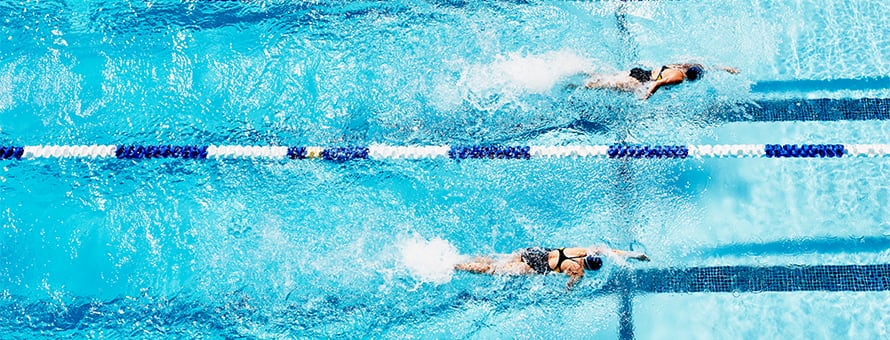Paris Olympics Could Be Landmark for Female Athletes

As Team USA prepares for a 2-week trip to Paris and a chance to make athletic history in the 2024 Summer Olympics, organizers are already eyeing another entry in the record books. These games could be the first in which women make up 50% of the participants. It’s a far cry from the first time Paris hosted the games in 1900 and comes at a time when interest in female sports is at an all-time high.
Dr. Doug Blais, a professor of sport management at Southern New Hampshire University (SNHU), answered questions recently about the booming interest in women's sports and what it means for the industry, media and society at large.
What are some of the factors leading to the growing interest in women’s sports recently?
 There are several factors that have led to the growing interest in women’s sports. Many would point to the recent explosion of media coverage of the NCAA women’s basketball championship where close to 19 million fans tuned in to watch Caitlin Clark and the University of Iowa Hawkeyes take on the University of South Carolina Gamecocks. This was an 89% increase from the year before and beat the men’s NCAA championship ratings by over 4 million fans.
There are several factors that have led to the growing interest in women’s sports. Many would point to the recent explosion of media coverage of the NCAA women’s basketball championship where close to 19 million fans tuned in to watch Caitlin Clark and the University of Iowa Hawkeyes take on the University of South Carolina Gamecocks. This was an 89% increase from the year before and beat the men’s NCAA championship ratings by over 4 million fans.
However, this rise in popularity didn't happen overnight. It is the result of increasing media coverage for women's sports across major sports networks like ESPN, various social media outlets and numerous online platforms dedicated to women's sports. These platforms have collectively contributed to the growing visibility and appreciation for women's sport participation.
A recent Wasserman Media study found that women’s sports now comprise 15% of total sports media coverage, up from only 4% just a few short years ago. The study estimates with this continued growth, it could grow to 20% in 2025. This increase in coverage has enabled casual sports fans to become more invested in women's sports, as they discover the outstanding talent of these athletes and their compelling backstories.
How has female participation in the Olympics evolved over the years?
The 1900 Paris Olympics marked the first time women were allowed to compete, representing just 2.2% of the athletes. By the 1984 Los Angeles Olympics, the number had risen to 23%. At the most recent Olympics in Tokyo, women made up 48% of the athletes.
The 2024 Paris Olympics is aiming for gender parity, with women expected to constitute 50% of the athletes. Additionally, the International Olympic Committee is strongly encouraging each delegation to have one male and one female jointly carry their flag during the opening ceremony.
How has media coverage of women sports changed, and what impact does that have on audience interest and the sponsorship market for athletes?
Two major factors have contributed to an increase in media coverage for women’s sports: the growth of cable sport networks and expanded visibility across various platforms including social media, streaming services, and digital publications. This expanded coverage has afforded fans the opportunity to view women’s sports that had previously not been available.
I believe a major turning point was the 1999 Women’s World Cup when more than 40 million fans watched the United States defeat China. The stadium was sold out with a record crowd of over 90,000 spectators. This seminal event made sport marketers realize the power of women’s sport as an advertising vehicle. Since then, mainstream media has increased their coverage of women’s sports and more importantly, dedicated resources to telling the stories of these athletes.
In just the last year, Iowa women’s basketball hosted an outdoor game at Kinnick Stadium that drew over 55,000 fans, setting the single-game attendance record. Just a few months before, Nebraska women’s volleyball hosted an outdoor game and set a world record for the largest crowd to watch a women’s sporting event in the United States with over 92,000 fans in attendance.
This coverage has led to an increased interest in women’s sports which generates larger audiences and increased television ratings. The increase in ratings has a direct effect on the sponsorship market. SponsorUnited reported a 22% increase in sponsorship of women athletes and properties in just the last year.
What about the impact of social media?
It is all about storytelling. Social media provides the perfect platform for female athletes to connect with fans and share their stories. The same is true for teams and leagues. The various platforms provide the opportunity to bypass traditional media outlets and connect directly with fans. A recent study from the Tucker Center for Research on Girls and Women in Sport indicates that women athletes often receive higher levels of social media engagement compared to men’s sports, highlighting the power of social media.
This strong engagement allows women athletes to monetize their social media presence. For instance, Simone Biles has over 7 million Instagram followers and according to Forbes, she generates at least $5 million annually in endorsements. A 2023 SponsorUnited report on the top 100 college athlete name, image, and likeness (NIL) deals reveals that women account for 52% of the deals.
What are some of the major challenges that female athletes still face today?
While there has been dramatic growth in sport participation by girls and women in sport since the implementation of Title IX, there is still a long way to go before equality is achieved. Women still only receive 15% of media coverage and this lack of visibility impacts their ability to attract fans which directly affects the size of television contracts. These lower valued contracts impact the salaries women receive to play professional sports.
Social media offers a platform for girls to connect with female sports role models. However, there remains a significant lack of female representation in coaching, broadcasting, and various leadership roles within sport organizations.
Female athletes continue to face discrimination in various forms and are more likely to be experience pressure surrounding body image and overall appearance than men do.
How do you see the role of international events like the Olympics in shaping the future of women's sports?
Hallmark events like the Olympics and the World Cup provide a global platform where women can showcase their talents and achievements. The summer Olympics will be held from July 26 to August 11. This is traditionally a “quiet” time in sports which means the Olympics will receive a good deal of coverage from sport channels like ESPN and be featured in local news broadcasts throughout the country. This will allow athletes like Simone Biles to cement their legacy and younger athletes like Sha’Carri Richardson to burst onto the world stage.
The Olympics also allows newer sports to be showcased. For example, skateboarding debuted in the 2020 Tokyo games and Rayssa Leal, a Brazilian skateboarder won the silver medal at the age of 13. Coming off a gold medal in the X Games, Leal is expected to be on the podium again in Paris. Her success has brought attention to what is traditionally a male-dominated sport.
Flag football will debut at the 2028 Olympic games in Los Angeles. Acceptance into the Olympics signals the sport has truly arrived and is mainstream. There are currently 474,000 girls that are playing flag football in the United States. According to the National Federation of State High School Associations, there are 9 states that fully sanction girl’s flag football and 17 other states that are exploring pilot programs. Becoming an Olympic sport will catapult flag football to the next level and the American Flag Football League will use the momentum of the Olympics to grow their professional leagues (men and women) which launch in 2025.
How can journalists better highlight the stories and achievements of female athletes?
The industry has come a long way in how women’s sports are covered. Journalists now emphasize athletes’ ability rather than their appearance. While this is progress, it should be seen as the bare minimum. There needs to be a continued expansion and dedication to women’s sports. Journalists should focus on the quality of the sport and athletic performance without drawing comparisons to men’s sports.
Journalists and media outlets should provide year-round coverage of women’s sports and not solely focus on marque events like the Olympics, World Cup, or NCAA championships. This coverage should include more female sports journalists in addition to coaches, trainers, producers and agents. It wasn't until 2020 that we witnessed the first all-female sports broadcast, an NHL game between the Chicago Blackhawks and the St. Louis Blues, where every major broadcast position was held by a woman in celebration of International Women's Day. The goal should be to reach a point where such occurrences are no longer newsworthy or limited to specific celebrations.
Journalists should take a holistic approach to covering women's sports. Beyond reporting on games and events, they should utilize social media, podcasts, blogs and supplemental programming to highlight human interest and feature stories that showcase athletes' personalities and individual journeys.
Achieving these goals requires a collective commitment to gender equity from all stakeholders, including media companies, national and international governing bodies, professional leagues, collegiate and high school athletic associations, right down to every youth coach and parent encouraging young girls to pursue their athletic passions. Not until these practices are in place will we begin to see true gender equity and parity in sports.
Joe Cote is a writer and organic marketer at Southern New Hampshire University (SNHU), where he has worked since 2016. Previously he spent more than a dozen years as a reporter and editor at weekly and daily newspapers in Vermont and New Hampshire. He lives near SNHU's Manchester, New Hampshire campus with his wife and daughter. Connect with him on LinkedIn.
Explore more content like this article

SNHU Celebrates Largest Fall Commencement

Government Shutdown Update for Military Students

SNHU Celebrates the Inauguration of President Lisa Marsh Ryerson
About Southern New Hampshire University

SNHU is a nonprofit, accredited university with a mission to make high-quality education more accessible and affordable for everyone.
Founded in 1932, and online since 1995, we’ve helped countless students reach their goals with flexible, career-focused programs. Our 300-acre campus in Manchester, NH is home to over 3,000 students, and we serve over 135,000 students online. Visit our about SNHU page to learn more about our mission, accreditations, leadership team, national recognitions and awards.


